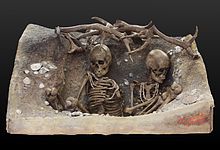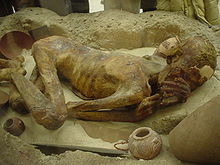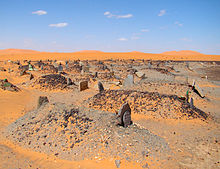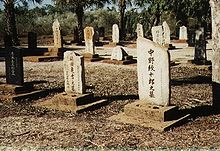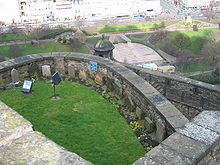- Burial
-
 Underwater funeral in Twenty Thousand Leagues Under the Sea from an edition with drawings by Alphonse de Neuville and Édouard Riou.
Underwater funeral in Twenty Thousand Leagues Under the Sea from an edition with drawings by Alphonse de Neuville and Édouard Riou.
Burial is the act of placing a person or object into the ground. This is accomplished by excavating a pit or trench, placing an object in it, and covering it over.
Contents
History
Further information: Paleolithic burial, Megalithic tomb, Grave field, Tumulus, Chariot burial, and Ship burialIntentional burial, particularly with grave goods, may be one of the earliest detectable forms of religious practice since, as Philip Lieberman suggests, it may signify a "concern for the dead that transcends daily life."[1] Though disputed, evidence suggests that the Neanderthals were the first human species to intentionally bury the dead, doing so in shallow graves along with stone tools and animal bones.[2] Exemplary sites include Shanidar in Iraq, Kebara Cave in Israel and Krapina in Croatia. Some scholars, however argue that these bodies may have been disposed of for secular reasons.[3]
The earliest undisputed human burial, discovered so far, dates back 130,000 years. Human skeletal remains stained with red ochre were discovered in the Skhul cave at Qafzeh, Israel. A variety of grave goods were present at the site, including the mandible of a wild boar in the arms of one of the skeletons.[4]
Prehistoric cemeteries are referred to by the more neutral term grave field. They are one of the chief sources of information on prehistoric cultures, and numerous archaeological cultures are defined by their burial customs, such as the Urnfield culture of the European Bronze Age.
Reasons for human burial
After death, a body will decay. Burial is not necessarily a public health requirement. Contrary to conventional wisdom, the WHO advises that only corpses carrying an infectious disease strictly require burial.[5][6]
Human burial practices are the manifestation of the human desire to demonstrate "respect for the dead", and to prevent the possibilities of revenants [ghosts] harming the living. Cultures vary in their mode of respect.
Among the reasons for this are:
- Respect for the physical remains. If left lying on top of the ground, scavengers may eat the corpse, considered disrespectful to the deceased in many (but not all) cultures. In Tibet, Sky burials return the remains to the cycle of life and acknowledge the body as "food," a core tenet of some Buddhist practices.
- Burial can be seen as an attempt to bring closure to the deceased's family and friends. Psychologists in some Western Judeo-Christian quarters, as well as the US funeral industry, claim that by interring a body away from plain view, the pain of losing a loved one can be lessened.
- Many cultures believe in an afterlife. Burial is sometimes believed to be a necessary step for an individual to reach the afterlife.
- Many religions prescribe a particular way to live, which includes customs relating to disposal of the dead.
- A decomposing body releases an unpleasant smell, so burial is a way of preventing that smell from reaching the open air.
Burial methods
In many cultures, human corpses were usually buried in soil. The roots of burial as a practice reach back into the Middle Palaeolithic and coincides with the appearance of Homo sapiens neanderthalensis and Homo sapiens, in Europe and Africa respectively. As a result, burial grounds are found throughout the world. Through time, Mounds of earth, temples, and underground caverns were used to store the dead bodies of ancestors. In modern times, the custom of burying dead people below ground with a stone marker to mark the place is used in almost every modern culture, although other means such as cremation are becoming more popular in the west (cremation is the norm in India and mandatory in Japan[citation needed]).
Some burial practices are heavily ritualized; others are simply practical.
Natural burial
While seen as a new trend in modern burial, natural burial, the process by which a body is returned to the earth to decompose naturally in soil, has been practiced in Islam for almost 1500 years.[citation needed] Natural burial became popularized in the United Kingdom in the early 1990s by Ken West, a professional cemeterian for the City of Carlisle responding to the U.K's call for changes in government that aligned with the United Nations' Environmental Program Local Agenda 21.[citation needed] The practice is gaining ground rapidly and has now expanded to Australia, Germany, the Netherlands, North America, China and Japan.[citation needed]
A new form of burial which previously freeze-dries the body with liquid nitrogen has been developed by the Swedish company Promessa Organic AB, which puts it forward as an environmentally friendly alternative to traditional casket and cremation burials.
Prevention of decay
Embalming is the practice of preserving a body against decay, and is used in many cultures. Mummification is a more extensive method of embalming, further delaying the decay process.
Bodies are often buried wrapped in a shroud or placed in a coffin (or in some cases, a casket). A larger container may be used, such as a ship. In the United States, coffins are usually covered by a grave liner or a burial vault, which prevents the coffin from collapsing under the weight of the earth or floating away during a flood.
These containers slow the decomposition process by (partially) physically blocking decomposing bacteria and other organisms from accessing the corpse. An additional benefit of using containers to hold the body is that if the soil covering the corpse is washed away by a flood or some other natural process, the corpse will still not be exposed to open air.
Inclusion of clothing and personal effects
The body may be dressed in fancy and/or ceremonial clothes. Personal objects, such as a favorite piece of jewelry or photograph, of the deceased may be included with the body. This practice, also known as the inclusion of grave goods, serves several purposes:
- In funeral services, the body is often put on display. Many cultures feel that the deceased should be presented looking his/her finest.
- The inclusion of ceremonial garb and sacred objects is sometimes viewed as necessary for reaching the afterlife.
- The inclusion of personal effects may be motivated by the beliefs that in the afterlife a person will wish to have with them what was important to them on earth. Alternatively, in some cultures it is felt that when a person dies, their possessions (and sometimes people connected to them such as wives) should go with them out of loyalty or ownership.
- Though not generally a motivation for the inclusion of grave goods with a corpse, it is worth considering that future archaeologists may find the remains (compare time capsule). Artifacts such as clothing and objects provide insight into how the individual lived. This provides a form of immortality for the deceased.
Body positioning
Burials may be placed in a number of different positions. Christian burials are made extended, i.e., lying flat with arms and legs straight, or with the arms folded upon the chest, and with the eyes and mouth closed. Extended burials may be supine (lying on the back) or prone (lying on the front). However, in some cultures, being buried face down shows marked disrespect. Other ritual practices place the body in a flexed position with the legs bent or crouched with the legs folded up to the chest. Warriors in some ancient societies were buried in an upright position. In Islam, the head is pointed toward and the face is turned toward Mecca, the holiest city in Islam. Many cultures treat placement of dead people in an appropriate position to be a sign of respect even when burial is impossible.
In nonstandard burial practices, such as mass burial, the body may be positioned arbitrarily. This can be a sign of disrespect to the deceased, or at least nonchalance on the part of the inhumer, or due to considerations of time and space.
Orientation
Historically, Christian burials were made supine east-west, with the head at the western end of the grave. This mirrors the layout of Christian churches, and for much the same reason; to view the coming of Christ on Judgment day (Eschaton). In many Christian traditions, ordained clergy are traditionally buried in the opposite orientation, and their coffins carried likewise, so that at the General Resurrection they may rise facing, and ready to minister to, their people.
In Islam, the grave should be aligned perpendicular to the Qibla (i.e. Mecca). (see Islamic funeral)
Inverted burial
For humans, maintaining an upside down position, with the head vertically below the feet, is highly uncomfortable for any extended period of time, and consequently burial in that attitude (as opposed to attitudes of rest or watchfulness, as above) is highly unusual and generally symbolic. Occasionally suicides and assassins were buried upside down, as a post-mortem punishment and (as with burial at cross-roads) to inhibit the activities of the resulting undead.
In Gulliver's Travels, the Lilliputians buried their dead upside down:
They bury their dead with their heads directly downward, because they hold an opinion, that in eleven thousand moons they are all to rise again; in which period the earth (which they conceive to be flat) will turn upside down, and by this means they shall, at their resurrection, be found ready standing on their feet. The learned among them confess the absurdity of this doctrine; but the practice still continues, in compliance to the vulgar.—Jonathan Swift, Jonathan SwiftSwift's notion of inverted burial might seem the highest flight of fancy, but it appears that among English millenarians the idea that the world would be "turned upside down" at the Apocalypse enjoyed some currency. There is at least one attested case of a person being buried upside down by instruction; a Major Peter Labelliere of Dorking (d. June 4, 1800) lies thus upon the summit of Box Hill.[7] Similar stories have attached themselves to other noted eccentrics, particularly in southern England, but not always with a foundation in truth.[8]
Burial among African-American slaves
In the African-American slave community, slaves quickly familiarized themselves with funeral procedures and the location of gravesites of family and friends. Specific slaves were assigned to prepare dead bodies, build coffins, dig graves, and construct headstones. Slave funerals were typically at night when the workday was over, with the master present to view all the ceremonial procedures. Slaves from nearby plantations were regularly in attendance.
At death, a slave’s body was wrapped in cloth. The hands were placed across the chest, and a metal plate was placed on top of their hands. The reasoning for the plate was to hinder their return home by suppressing any spirits in the coffin. Often, personal property was buried with slaves to appease spirits. The coffins were nailed shut once the body was inside, and carried by hand or wagon, depending on the property designated for slave burial site. Slaves were buried east to west, with the head facing east and their feet to the west. This positioning represented the ability to rise without having to turn around at the call of Gabriel’s trumpet. Gabriel’s trumpet would be blown in the eastern sunrise.
Burial in the Bahá'í Faith
Bahá'í burial law prescribes both the location of burial and burial practices and precludes cremation of the dead. It is forbidden to carry the body for more than one hour's journey from the place of death. Before interment the body should be wrapped in a shroud of silk or cotton, and a ring should be placed on its finger bearing the inscription "I came forth from God, and return unto Him, detached from all save Him, holding fast to His Name, the Merciful, the Compassionate". The coffin should be of crystal, stone or hard fine wood. Also, before interment, a specific Prayer for the Dead[9] is ordained. The body should be placed with the feet facing the Qiblih. The formal prayer and the ring are meant to be used for those who have reached fifteen years of age.[10]
Locations
Where to bury
Apart from sanitary and other practical considerations, the site of burial can be determined by religious and socio-cultural considerations.
Thus in some traditions, especially with an animistic logic, the remains of the dead are "banished" for fear their spirits would harm the living if too close; others keep remains close to help surviving generations.
Religious rules may prescribe a specific zone, e.g. some Christian traditions hold that Christians must be buried in "consecrated ground", usually a cemetery; an earlier practice, burial in or very near the church (hence the word churchyard), was generally abandoned with individual exceptions as a high posthumous honour; also many existing funeral monuments and crypts remain in use.
Royalty and high nobility often have one or more "traditional" sites of burial, generally monumental, often in a palatial chapel or cathedral; see examples on Heraldica.org.
In North America, private family cemeteries were common among wealthy landowners during the 18th and 19th centuries. Many prominent people were buried in private cemeteries on their respective properties, sometimes in lead-lined coffins. Many of these family cemeteries were not documented and were therefore lost to time and abandon; their grave markers having long since been pilfered by vandals or covered by forest growth. Their locations are occasionally discovered during construction projects.
Marking the location of the burial
Most modern cultures mark the location of the body with a headstone. This serves two purposes. First, the grave will not accidentally be exhumed. Second, headstones often contain information or tributes to deceased. This is a form of remembrance for loved ones; it can also be viewed as a form of immortality, especially in cases of famous people's graves. Such monumental inscriptions may subsequently be useful to genealogists and family historians.
In many cultures graves will be grouped, so the monuments make up a necropolis, a "city of the dead" parallelling the community of the living.
Unmarked grave
In many cultures graves are marked with durable markers, or monuments, intended to help remind people of the buried person. An unmarked grave is a grave with no such memorial marker.
The corpse of Pope Formosus was actually disinterred, placed on trial (see Cadaver Synod), found guilty, and ultimately thrown into the River Tiber.
Anonymous burial
Another sort of unmarked grave is a burial site with an anonymous marker, such as a simple cross; boots, rifle and helmet; a sword and shield; a cairn of stones; or even a monument. This may occur when identification of the deceased is impossible. Although many unidentified deceased are buried in potter's fields, some are memorialized, especially in smaller communities or in the case of deaths publicized by local media.
Many countries have buried an unidentified soldier (or other member of the military) in a prominent location as a form of respect for all unidentified war dead. The United Kingdom's Tomb of the Unknown Warrior is in Westminster Abbey, France's is buried underneath the Arc de Triomphe, Italy's is buried in the Monumento al Milite Ignoto in Rome, Canada's is buried at the National War Memorial in Ottawa, Australia's Tomb of the Unknown Soldier is located at the Australian War Memorial in Canberra, New Zealand's Tomb of the Unknown Warrior is in Wellington and the United States' Tomb of the Unknown Soldier is located at Arlington National Cemetery.
Many cultures practise anonymous burial as a norm, not an exception. For instance, in parts of eastern Germany, up to 43% of burials are anonymous.[11] According to Christian Century magazine, the perspective of the Roman Catholic Church is that anonymous burials reflect a dwindling belief in God, but others claim that the practice relates more to the exorbitant cost of grave markers and the solitary nature of German life.[12]
Secret burial
In rare cases, a known person may be buried without identification, perhaps to avoid desecration of the corpse, grave robbing, or vandalism of the burial site. This may be particularly the case with infamous or notorious figures. In other cases, it may be to prevent the grave from becoming a tourist attraction or a destination of pilgrimage. Survivors may cause the deceased to be buried in a secret location or other unpublished place, or in a grave with a false name (or no name at all) on the marker.
When Walt Disney was cremated his ashes were buried in a secret location in Forest Lawn Memorial Park Cemetery, California. Some burial sites at Forest Lawn, such as those of Humphrey Bogart, Mary Pickford and Michael Jackson are secluded in private gated gardens or mausoleums with no public access. A number of tombs are also kept from the public eye. Forest Lawn's Court of Honor indicates that some of its crypts have plots which are reserved for individuals who may be "voted in" as "Immortals"; no amount of money can purchase a place. Photographs taken at Forest Lawn are not permitted to be published, and their information office usually refuses to reveal exactly where the remains of famous people are buried. Although the cemetery's owners state that this is meant to deter gravesite tourism, some critics say that the cemetery wishes visitors to purchase memorabilia at the funeral home's numerous gift shops instead of taking photographs for free, especially in the case of grave markers notable for their beauty.[13]
Multiple bodies per grave
Some couples or groups of people (such as a married couple or other family members) may wish to be buried in the same plot. In some cases, the coffins (or urns) may simply be buried side by side. In others, one casket may be interred above another. If this is planned for in advance, the first casket may be buried more deeply than is the usual practice so that the second casket may be placed over it without disturbing the first. In many states in Australia all graves are designated two or three depth (depending of the water table) for multiple burials, at the discretion of the burial rights holder, with each new interment atop the previous coffin separated by a thin layer of earth. As such all graves are dug to greater depth for the initial burial than the traditional six feet to facilitate this practice.
Mass burial is the practice of burying multiple bodies in one location. Civilizations attempting genocide often employ mass burial for victims. However, mass burial may in many cases be the only practical means of dealing with an overwhelming number of human remains, such as those resulting from a natural disaster, an act of terrorism, an epidemic, or an accident. This practice has become less common in the developed world with the advent of genetic testing, but even in the 21st century remains which are unidentifiable by current methods may be buried in a mass grave.
Individuals who are buried at the expense of the local authorities and buried in potter's fields may be buried in mass graves. Wolfgang Amadeus Mozart was once believed to have been buried in such a manner, but today it is known that such burials were never allowed in Mozart's Vienna whose Magistrate refused to agree to the burial regulations decreed by Joseph II.[disambiguation needed
 ] In some cases, the remains of unidentified individuals may be buried in mass graves in potter's fields, making exhumation and future identification troublesome for law enforcement.
] In some cases, the remains of unidentified individuals may be buried in mass graves in potter's fields, making exhumation and future identification troublesome for law enforcement.Naval ships sunk in combat are also considered mass graves by many countries. For example, U.S. Navy policy declares such wrecks a mass grave and forbids the recovery of remains. In lieu of recovery, divers or submersibles may leave a plaque dedicated to the memory of the ship or boat and its crew, and family members are invited to attend the ceremony.
Sites of large former battlefields may also contain one or more mass graves. Douaumont ossuary is one such mass grave, and it contains the remains of 130,000 soldiers from both sides of the battle of Verdun.
Catacombs also constitute a form of mass grave. Some catacombs, for example those in Rome, were designated as a communal burial place. Some, such as the catacombs of Paris, only became a mass grave when individual burials were relocated from cemeteries marked for demolition.
Judaism does not generally allow multiple bodies in a grave. An exception to this is a grave in the military cemetery in Jerusalem, where there is a kever achim (Hebrew, "grave of brothers") where two soldiers were killed together in a tank and are buried in one grave. As the bodies were so fused together with the metal of the tank that they could not be separately identified, they were buried in one grave (along with parts of the tank).
Cremation
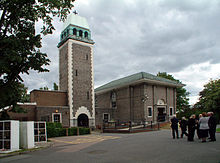 Honor Oak Crematorium, Camberwell New Cemetery, London. Architect Maurice Webb - geograph.org.uk - 45058
Honor Oak Crematorium, Camberwell New Cemetery, London. Architect Maurice Webb - geograph.org.uk - 45058
There are several common alternatives to burial. In cremation the body of the deceased is burned in a special oven. Most of the body is burnt during the cremation process, leaving only a few pounds of bone fragments. Bodies of small children and infants often produce very little in the way of "ashes", as ashes are composed of bone, and young people have softer bones, largely cartilage. Often these fragments are processed (ground) into a fine powder, which has led to cremated remains being called ashes. In recent times, cremation has become a popular option in the western world.
There is far greater flexibility in dealing with the remains in cremation as opposed to the traditional burial. Some of the options include scattering the ashes at a place close to the heart of the deceased or keeping the ashes at home. Ashes can also be buried underground or in a columbarium niche.
A method with similar benefits, but ecologically superior, is freeze-drying the corpse.
Live burial
Live burial sometimes occurs, in which individuals are buried while still alive. Having no way of escaping interment, they die in place, typically by asphyxiation, dehydration, starvation, or (in cold or hot climates) exposure. People may come to be buried alive in a number of different ways:
- Intentional: buried alive as a method of execution or murder, called immurement when the person is entombed within walls. In ancient Rome, Vestal Virgins who broke their vows were punished in this way.[citation needed]
- Accidental: A person or group of people in a cave, mine, or other underground area may be sealed underground due to an earthquake, cave in, or other natural disaster or accident. Live burial may also occur due to avalanches on mountain slopes.
- Inadvertent: People have been unintentionally buried alive because they were pronounced dead by a coroner or other official, when they were in fact still alive.
Writer Edgar Allan Poe wrote a number of stories and poems about premature burial, including a story called "The Premature Burial." These works inspired a widespread popular fear of this appalling but unlikely event. Various expedients have been devised to prevent this event, including burying live telephones or telemetry sensors in graves.
Burial at cross-roads
Historically, burial at cross-roads was the method of disposing of executed criminals and persons who have committed suicide. Cross-roads form a crude cross shape and this may have given rise to the belief that these spots were selected as the next best burying-places to consecrated ground.[citation needed] Another possible explanation is that the ancient Teutonic (Germanic) ethnic groups often built their altars at the cross-roads, and since human sacrifices, especially of criminals, formed part of the ritual, these spots came to be regarded as execution grounds.[citation needed] Hence after the introduction of Christianity, criminals and suicides were buried at the cross-roads during the night, in order to assimilate[clarification needed] as far as possible their funeral to that of the pagans.[citation needed] An example of a cross-road execution-ground was the famous Tyburn in London, which stood on the spot where the Roman road to Edgware and beyond met the Roman road heading west out of London.
Superstition also played a part in the selection of cross-roads in the burial of suicides. Folk belief often held such individuals could rise as some form of undead (such as a vampire) and burying them at cross-roads would inhibit their ability to find and wreak havoc on their living relations and former associates.[citation needed]
 This article incorporates text from a publication now in the public domain: Chisholm, Hugh, ed (1911). Encyclopædia Britannica (11th ed.). Cambridge University Press.
This article incorporates text from a publication now in the public domain: Chisholm, Hugh, ed (1911). Encyclopædia Britannica (11th ed.). Cambridge University Press.Burial of animals
By humans
In addition to burying human remains, many human cultures also regularly bury animal remains.
Pets and other animals of emotional significance are often ceremonially buried. Most families bury deceased pets on their own properties, mainly in a yard, with a shoe box or any other type of container served as a coffin. The Ancient Egyptians are known to have mummified and buried cats, which they considered deities.
By other animals
Humans are not always the only species to bury their dead. Chimpanzees and elephants are known to throw leaves and branches over fallen members of their family groups. In a particularly odd case, an elephant which trampled a mother and child buried its victim under a pile of leaves before disappearing into the bushes.[14]
Exhumation
The digging up of a buried body is called exhumation or disinterment, and is generally considered sacrilege or taboo by most cultures that bury their dead. Exceptions are sometimes allowed:
- If an individual dies in suspicious circumstances, the police may request exhumation in order to determine the cause of death.
- Deceased individuals who were either not identified or misidentified at the time of burial may be reburied if survivors so wish.[15]
- In Southern Chinese culture, graves are opened after a period of years. The bones are removed, cleaned, dried, and placed in a ceramic pot for reburial (in Taiwan), or in a smaller coffin to be taken home by the rest of the family (in Vietnam). The practice is called jiǎngǔ in Taiwan, or boc mo in Vietnam '揀骨 “digging up bones” and is an important ritual in the posthumous “care” of children for their deceased parents and ancestors. Failure to carry out this ritual is considered a failure of filial piety.
- Similarly in Hong Kong where real estate is at a premium, burials in government-run cemeteries are disinterred after six years under exhumation order. Remains are either collected privately for cremation or reburied in an urn or niche. Unclaimed burials are exhumed and cremated by the government.[16] Permanent burial in privately run cemeteries is allowed.
- Remains may be exhumed in order to be reinterred at a more appropriate location. For example, when the remains of MIA soldiers are discovered, or the case of Nicholas II of Russia and his family, who were exhumed from unmarked graves near Yekaterinburg to be reinterred in the Peter and Paul Fortress in St. Petersburg.
- The passing of time may mean political situations change and a burial can take place in different circumstances. Roger Casement was executed at Pentonville Prison in London on 3 August 1916 and buried in the prison grounds but his body was exhumed given a state funeral in Dublin on 1 March 1965.[17]
- The remains of the Venerable or the Blessed are sometimes exhumed to ensure their bodies lie in their correctly-marked graves, as their gravesites usually become places for devotees to gather, and also to collect relics. The bodies may also be transferred to a more dignified place. It also serves the purpose to see if they are supernaturally Incorrupt. An incorrupt corpse is no longer considered miraculous, but it is a characteristic of several known saints. Exhumation is no longer a requirement in the beatification process, but still may be carried out.
- Remains may be exhumed and reburied en masse when a cemetery is relocated, once local planning and religious requirements are met.[18]
- In rare, historical cases (e.g. Pope Formosus or Oliver Cromwell), a body may be exhumed for posthumous execution, dissection, or gibbeting.
- Notable individuals may be exhumed to answer historical questions. Many Ancient Egyptian mummies have been removed for study and public display.
- In the UK once the top of a coffin has been lowered below ground level in a burial if it raised again, say for example the grave sides are protruding and need further work, this is considered an exhumation and the Home Office are required to be notified and a full investigation undertaken. Therefore grave diggers in the UK are particularly careful to ensure that grave sites are dug with plenty of room for the coffin to pass.[19]
Once human remains reach a certain age, some cultures consider exhumation acceptable, especially if this is followed by later reburial following traditional burial rites. This serves several purposes:
- Cemeteries sometimes have a limited number of plots in which to bury the dead. Once all plots are full, older remains may be moved to an ossuary to accommodate more bodies, in accordance with burial contracts, religious[disambiguation needed
 ] and local burial laws.
] and local burial laws. - It enables archaeologists to search the remains to better understand human culture.
- It enables construction agencies to clear the way for new constructions. One example of this is cemeteries in Chicago next to O'Hare International Airport to expand the runways.
Frequently, cultures have different sets of exhumation taboos. Occasionally these differences result in conflict, especially in cases where a culture with more lenient exhumation rules wishes to operate on the territory of a different culture. For example, United States construction companies have run into conflict with Native American groups that have wanted to preserve their burial grounds from disturbance.
Jewish law forbids the exhumation of a corpse.[20]
In folklore and mythology, exhumation has also been frequently associated with the performance of rites to banish undead manifestations. An example is the Mercy Brown Vampire Incident of Rhode Island, which occurred in 1892.
Reinterment
Reinterment refers to the reburial of a corpse.[21]
Secondary burial
Secondary burial is a burial, cremation, or inhumation that is dug into a pre-existing barrow or grave any time after its initial construction. It is often associated with the belief that there is a liminal phase between the time that a person dies and finally decays.[22]
Alternatives to burial
In most cases these alternatives still intend to maintain respect for the dead, but some intend to prolong the display of the remains.
- Burial at sea is the practice of depositing the body in an ocean or other large body of water instead of soil. It may be disposed in a coffin, or without one. Because of the particular logistics of scattering ashes at sea, there are commercial services that do so for a fee.
- Funerary cannibalism is the practice of eating the remains. This may be for many reasons: for example to partake of their strength, to spiritually "close the circle" by reabsorbing their life into the family or clan, to annihilate an enemy, or due to pathological mental conditions. The Yanomami have the habit of cremating the remains and then eating the ashes with banana paste.
- Cremation is the incineration of the remains. This practice is common amongst Hindus and is becoming increasingly common in other cultures as well. If a family member wishes, the ashes can now be turned into a gem, similar to creating synthetic diamonds.
- Ecological funeral is a method of increasing the rate of decomposition in order to help fertilize the soil.
- Excarnation is the practice of removing the flesh from the corpse without interment. The Zoroastrians have traditionally left their dead on Towers of Silence, where the flesh of the corpses is left to be devoured by vultures and other carrion-eating birds. Alternatively, it can also mean butchering the corpse by hand to remove the flesh (sometimes referred to by the neologism "defleshing").
- The Use of an Ossuary for human skeletal remains among second temple Jews & early Christians.
- Gibbeting was the ancient practice of publicly displaying remains of criminals.
- Hanging coffins are coffins which have been placed on cliffs. They can be found in various locations, including China and the Philippines.
- Resomation involves disposal through an accelerated process of alkaline hydrolysis.
- Sky burial involves placing the body on a mountaintop.
- Cryonics is often mistakenly assumed as an alternative interment method. In fact it's a procedure to physically preserve a body. Cryonics supporters hope reviving individuals will be technologically feasible one day. See also information theoretical death; clinical death.
Notes and references
- ^ Philip Lieberman. (1991). Uniquely Human. Cambridge, Mass.: Harvard University Press. ISBN 0674921836. http://books.google.com/?id=3tS2MULo5rYC&pg=PA162&dq=Uniquely+Human+cognitive-linguistic+base.
- ^ Chris Scarre, The Human Past
- ^ "Evolving in their graves: early burials hold clues to human origins - research of burial rituals of Neanderthals". Findarticles.com. 2001-12-15. http://findarticles.com/p/articles/mi_m1200/is_24_160/ai_81827792/pg_1. Retrieved 2011-03-25.
- ^ Uniquely Human page 163. Books.google.com. http://books.google.com/books?id=3tS2MULo5rYC&pg=PA163&dq=Uniquely+Human++qafzeh&ei=F-AeR_ntI5WGpgLkrsWzBg&sig=k7GcMq8PU_B6tX56Cf95ENxmJIQ. Retrieved 2011-03-25.
- ^ "04--ARTI--Morgan--307-312" (PDF). http://publications.paho.org/english/dead_bodies.pdf. Retrieved 2011-03-25.
- ^ http://publications.paho.org/english/editorial_dead_bodies.pdf
- ^ Simpson, Jacqueline (August 2005). "The Miller's tomb: facts, gossip, and legend". Folklore 116 (2): 189. doi:10.1080/00155870500140230. http://www.findarticles.com/p/articles/mi_m2386/is_2_116/ai_n15727507/pg_1.
- ^ Simpson, Jacqueline (January—March 1978). "The World Upside down Shall Be: A Note on the Folklore of Doomsday". The Journal of American Folklore (American Folklore Society) 91 (359): 559–567. doi:10.2307/539574. JSTOR 539574.
- ^ "Bahá'í Reference Library - The Kitáb-i-Aqdas, Pages 101-102". Reference.bahai.org. 2010-12-31. http://reference.bahai.org/en/t/b/KA/ka-14.html. Retrieved 2011-03-25.
- ^ "Baha'i Burial". Bahai-library.com. http://bahai-library.com/compilation_bahai_burial. Retrieved 2011-03-25.
- ^ "Stonereport News for your natural stone business". Stonereport.com. http://www.stonereport.com/ihtm/detail-e.htm?aclnews=10:0:294:::0:242:. Retrieved 2011-03-25.
- ^ "Europeans seek the grave's anonymity - anonymous burials". http://www.findarticles.com/p/articles/mi_m1058/is_n17_v113/ai_18311722.[dead link]
- ^ "Beneath Los Angeles". Beneath Los Angeles. http://beneathlosangeles.com/. Retrieved 2011-03-25.
- ^ Kenya elephant buries its victims (2004, BBC) - http://news.bbc.co.uk/1/hi/world/africa/3818833.stm
- ^ "Accident victim's body is exhumed". BBC News. July 6, 2006. http://news.bbc.co.uk/1/hi/northern_ireland/5153864.stm. Retrieved April 27, 2010.
- ^ "Coffin Burial". Fehd.gov.hk. http://www.fehd.gov.hk/english/cc/land.html. Retrieved 2011-03-25.
- ^ National Archives, London, CAB 128/39
- ^ Cemetery Relocation at the Wayback Machine
- ^ Department for Community Affairs, Coroners and Burials, 2007.
- ^ Lamm, Maurice. "The Grave". Chabad.org. http://www.chabad.org/library/article_cdo/aid/281579/jewish/The-Grave.htm.
- ^ "Man Andrew Jackson killed in duel to be reburied". Associated Press. 24 June 2010. http://www.herald-dispatch.com/news/briefs/x1525457073/Man-Andrew-Jackson-killed-in-duel-to-be-reburied.
- ^ 1991 Metcalf, Peter & Richard Huntington. Celebrations of Death: The Anthropology of Mortuary Ritual. Cambridge Press, New York. Print.
See also
- Burial mound
- Cemetery
- Coffin
- Health risks from dead bodies
- Funeral
- Grave (burial)
- Green burial
- Headstone
- Museum of Funeral Customs
- Thanatology
- Corpse road
External links
Death and related topics In medicine Abortion · Autopsy · Brain death · Clinical death · End-of-life care · Euthanasia · Lazarus syndrome · Terminal illness · Mortal woundLists Causes of death by rate · Expressions related to death · Natural disasters · People by cause of death · Premature obituaries · Preventable causes of death · Notable deaths in 2007 · Notable deaths in 2008 · Notable deaths in 2009 · Notable deaths in 2010 · Unusual deathsMortality After death Body: Burial · Coffin birth · Cremation · Cryonics · Decomposition · Disposal · Mummification · Promession · Putrefaction · Resomation
Other: Afterlife · Cemetery · Customs · Death certificate · Funeral · Grief · Intermediate state · Mourning · VigilParanormal Legal Other Death and culture · Death (personification) · Fascination with death · Genocide · Last Rites · Martyr · Moribundity · Sacrifice (Human · Animal) · Suicide · Assisted suicide · Thanatology · WarCategories:- Death customs
- Archaeological features
Wikimedia Foundation. 2010.

